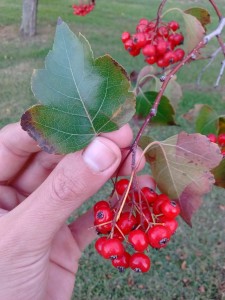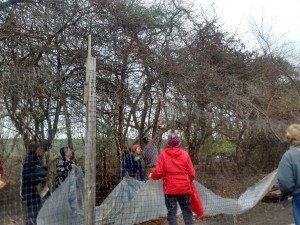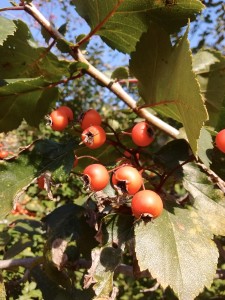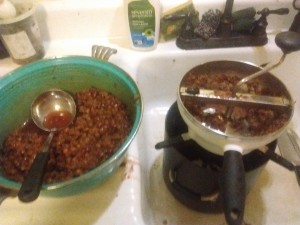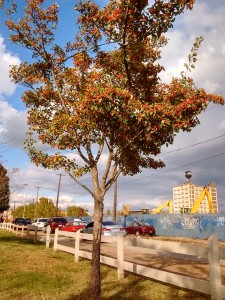
- Hawthorns planted near 15th & Arch! Check out the leaf shape and fruit blossom end to help with identification.
In December, POPHarvest’s last community gleaning of the season was a hawthorn berry harvest from the edges of Teens 4 Good’s farm at the Schuylkill Center for Environmental Education. Want to know about future events? Feel free to add yourself to the POPHarvest listserv for 2016’s gleaning announcements!

- POPHarvesters at Teens 4 Good farm shaking fruit from their tall hawthorn trees. These specimens with incredibly long thorns were long ago planted as a natural hedgerow and deer fence.
Hawthorns (Crataegus) are among the most prevalent genus with parts for human consumption that are planted as street and vacant lot stabilizing trees in Philadelphia. They’re related to apples, roses, and many other popular edible fruits. As such, they look a lot like some crabapples, but both are easy to distinguish once you recognize the slight differences in their respective leaves and fruit–and hawthorn berries seem to last much longer through the winter without getting shriveled and rotten as compared to crabs. Using the photos in this post as a guide, you can see that hawthorn leaves have serration and lobes, somewhat akin to a round maple leaf, whereas crabapples and apple trees have much more singular, oval leaf shapes. Hawthorn berries have a much more pronounces blossom end (the bottom of the fruit), and crabapple blossom ends that are small enough to look like hawthorns are smooth. It’s also safe to nibble them a bit for ID purposes, as both are edible. Crabapples will be super tart. Hawthorns will have very little flavor, but some sweetness.
There are anywhere between 200 and 300 species of Crataegus, and North America has the largest variation among its native Hawthorns. However, all seem to have similar nutritional and medicinal benefits. The fruits (haws), flowers, and leaves been used medicinally for centuries to prevent and treat conditions of the heart.
Their berries are not as simple to prepare or conventionally delicious as apples or peaches, but they’re one of the few fruits that are still hanging on trees ready to be picked after recent below freezing temps and snow, they pack a nutritional and medicinal punch that’s well worth being informed about!
Recipe Ideas
*Important* Hawthorn berry seeds contain amygdalin, cyanide bonded with a sugar. In your small intestine, amygdalin converts to hydrogen cyanide. Besides hawthorn, many members of the rose family, including apple, almond, plum, apricot, and peach, have amygdalin as well. I’ve had trouble finding any information on how many hawthorn seeds you’d need to consume before you’d have a reaction, but it’s definitely a lot. That being said, be careful. If you’re infusing the berries in anything, don’t crush or pulverize them with the seed in, and use a sieve or food mill to separate the seeds in any recipes.
With my POPHarvest haul, I took a full day to experiment in the kitchen. These are not quick fruits, though now that I know what I’m doing, hopefully they’ll be easier for you. Get in the slow-cooker mindset, set up a multitasking list, find a good album, podcast, or audiobook, and get to making!

- Cooking with hawthorns involves a lot of this: slowly softening and cooking down the berries, passing them through a food mill, and adding them back to the heat with other ingredients and without seeds.
I made a variation of this Hawthorn berry ketchup recipe with the ingredients I had on hand. Contrary to the high fructose corn syrup-laden ketchup most are accustomed to, what I ended up with seems much more like it will be a good meat or mushroom marinade than a ketchup, but I’m happy with the results. I slowly softened the berries in water and vinegar, added the sugar and salt gradually, and tasted as I went.
I was much more proud of the results of hawthorns in what I’m calling a “Rosaceae Butter” (all of the main ingredients were from the Rose Family). I cleaned my fridge of some long overdue gleaning leftovers–a few varieties of apples, Asian pears, and quince–added them to about 2 quarts of milled hawthorns, added some cinnamon, cardamom, nutmeg, brown sugar, and a bit of Trifoliate Orange juice to taste, and let it all simmer until it was the consistency of a good apple butter. I’ve since been using it as an apple sauce substitute or a spread on breads or crackers.
This blog post entitled “What can I do with hawthorn berries?” has a long list of great suggestions with links to various recipes. The berries are exceptionally high in pectin, a necessary part of jelly-making, so they’d also be great to add to any other jelly recipes you have interest in. There are some fun facts and recipes on this Eat The Weeds Blog, too.
Medicinal Tradition
Separately from the POPHarvest event, I harvested a quart of hawthorns from trees on my block to make a medicinal heart elixir–macerated hawthorns infused in apple brandy and honey. Very, very simple, and very good, physically and emotionally heartwarming medicine.
If you still want more, I really like the plant profile provided here on Sacredearth.com for hawthorn. Otherwise, learn, harvest, experiment safely, ask questions, and come to future POPHarvest events!
Precautions
It’s important that you are all aware of precautions when testing out a new food or herb. Though it is edible and safe for most, all people are different, and there are some contraindications with certain drugs (see below). Hawthorn is time-tested, potent heart-health medicine and should be treated as such. I think reading all this information on Hawthorn from University of Maryland is good to read. Here’s a snippet:
“The use of herbs is a time-honored approach to strengthening the body and treating disease. Herbs, however, contain components that may trigger side effects and interact with other herbs, supplements, or medications. For these reasons, you should take herbs with care, under the supervision of a health care provider qualified in the field of botanical medicine.
“Side effects of Hawthorn are rare, but may include headache, nausea, and palpitations (a feeling of a racing heart). One review of 29 clinical studies with more than 5,500 people found that hawthorn was safe when used in recommended dosages. Doses found to be safe were from 160 to 1,800 mg daily, and from 3 to 24 weeks in length. You may not notice any improvement for 6 to 12 weeks….”
Disclaimer
The Philadelphia Orchard Project stresses that you should not consume parts of any wild edible plants, herbs, weeds, trees, or bushes until you have verified with your health professional that they are safe for you. As with any new foods that you wish to try, it is best to introduce them slowly into your diet in small amounts.
The information presented on this website is for informational, reference, and educational purposes only and should not be interpreted as a substitute for diagnosis and treatment by a health care professional. Always consult a health care professional or medical doctor when suffering from any health ailment, disease, illness, or injury, or before attempting any traditional or folk remedies. Keep all plants away from children. As with any natural product, they can be toxic if misused.
To the best of our knowledge, the information contained herein is accurate and we have endeavored to provide sources for any borrowed material. Any testimonials on this web site are based on individual results and do not constitute a warranty of safety or guarantee that you will achieve the same results.
Neither the Philadelphia Orchard Project nor its employees, volunteers, or website contributors may be held liable or responsible for any allergy, illness, or injurious effect that any person or animal may suffer as a result of reliance on the information contained on this website nor as a result of the ingestion or use of any of the plants mentioned herein.
